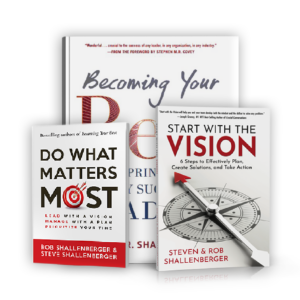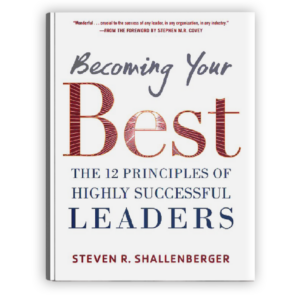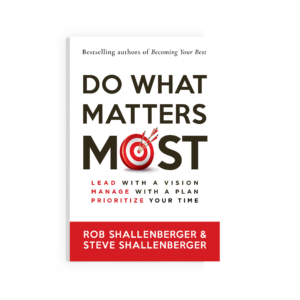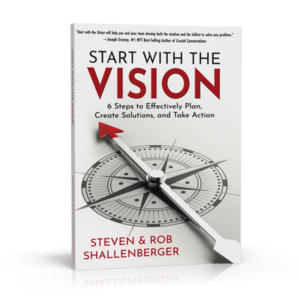Steve Shallenberger: Greetings to our Becoming Your Best podcast listeners, wherever you may be today! We have a fun subject to talk about. It is saying ‘no’ with consideration, courage, and conviction. Now, I think I ought to clarify a little bit: this is not just, “Will you go to the store with me?” or “Would you mind taking this assignment?” If you want to find ways to say ‘no’ to those, that’s okay. You can go on the internet and find 25 funny ways to say ‘no’. But that is not what I’m talking about today. We’re talking about the bigger stakes, perhaps emotionally-seated issues and you might be in a bad situation, or you just feel uncomfortable or you don’t want to hurt someone. And this is illustrated, that’s the kind of ‘no’ I’m talking about. It’s how you get out of that situation gracefully.
So, the title is “Say No with Consideration, Courage, and Conviction. To introduce this, I’d like to tell you about the story of Jerry. It’s not his real name, but he’s a close friend, I love Jerry. He recently lost his spouse a number of months ago, earlier in the year – it had been a protracted ailment injury is what took her, unfortunately. And after an appropriate time, Jerry started dating. Now, this was a new experience for Jerry because he hadn’t been dating for 25 to 30 years. And he developed three to four friendships at once – I mean, you know, over a short period of time. And, of course, not revealing to the others that he had several friends. And he liked each one but was starting to feel really stressed and felt like life was getting very complicated. And so, he came to the conclusion to focus on just one of those relationships and, as we were visiting, and because we are friends, he said, “Well, what are your thoughts? How can I tell these other ladies that I care for them, but have decided to move on? I just don’t want to hurt their feelings.” You could tell this was a sincere desire to do just that, not hurt anyone.
And so, my friend said – and he is a key executive, a president of an outstanding organization. He said, “You ought to do a podcast on how to say ‘no’.” And that is, really, the inspiration for this podcast. As we talked about it, we came up with a few thoughts and he had a plan of action, so I’m just going to tell you about it. Whatever the reason may be for wanting to say ’no’ – for example, here are some of the following: if you’re dating someone, regardless of how old you are, and you feel it isn’t right, how do you say ‘no’ in a way that you’re true to your feelings and conviction, yet considerate of the other person? Or here’s another situation: let’s say that you’re in a toxic relationship. It’s just not working at all. How do you get out of that? Whether it’s a personal relationship or a professional relationship. Let’s just delve in a little deeper on this one: if you’re in a work relationship, and it’s going south and you’re hating your work, or the expectations are not what you had in mind, how do you get out of that situation? What do you do, anyhow? Or let’s say that you’re in a company or leading a company, a team, or a project where it’s just not happening? I mean, you’ve been working a long time on it, and you’ve been doing everything you know how, and it’s not being successful. And then, you just feel bad about an idea or direction that you’re going. Or if someone asked you to just do something that you just don’t feel is right or you feel uncomfortable with. And the last is, you just don’t feel right about something. So what can you do? What are the best ways to say ‘no’ with consideration, courage, and conviction?
Well, we would like to offer today, in this podcast, to our wonderful listeners – and I underscore this, how grateful we are that you’re part of this show, and that you have the interest and that you’re the type of person that’s trying to improve. So, huge kudos to you! So, let’s talk about a few ideas that may be helpful to you. Here are four ideas.
Number one is, be really determined, be principles-centered. I love this concept! And Stephen Covey shared this idea so if you can imagine the circle in the middle with a wheel going out, the spokes of the wheel. When you are principles-centered, and particularly as we think about the 12 Principles, they’re a huge foundation for this center. And especially when the storm comes, your foundation – this is a huge foundation – when it is built on the foundation of principles, and the storm comes, it’s not going to be blown or washed away. And so, this is a great, powerful center. And what we do is we think of the alternatives because from your center comes your power of how you do things. It comes, for example, where you gain your self-esteem. So, it’s really important that we have a solid center. The alternative, if it’s not principles-centered – you could be, say, job-centered or spouse-centered or self-centered, money-centered, you know, church-centered. So, as you think about each one of those, how would you do something? So, let’s say you’re money centered, Where do you get your self-esteem? By how much money you have. If you want to get something done, What do you do? Yeah, you buy it, right? You buy it done. But if you’re money-centered, then also your happiness comes from the center. Can you ever have really enough money? You can see how if you’re job-centered it can take over your life. Your esteem may come from your title, for example. Or, how do you get things done from the power of your responsibilities. But when you’re principles-centered, that is far different. Then, as you think about your job, you’re working to be excellent in your job, but you also have a spouse or a partner. And so, you do certain things to be excellent there. And when you’re thinking about becoming your best, you can see how, when you have these 12 Principles at your center, they influence everything else.
And as I’ve gone through life – and let’s just kind of take a look at those, by the way, this foundation that we’re talking about that won’t be blown away or washed away, when you are determined that you will be true to character. Oh, that brings so much strength and confidence. Or – these are among the 12 Principles of Highly Successful Leaders – when you have a personal vision that answers so many questions as you live a life by design and don’t live one by default based on what’s going on outside. And this provides inspiration, direction. When you have goals for this year, especially by these roles that we’re talking about, you actually start creating a direction that fills your life with positive things.
So, now we’re all getting back to, well, how do you say no with consideration, courage, and conviction? It is this kind of clear understanding that helps you now start having the basis to do that when you have your goals and you’re doing pre-week planning. And we’ve already determined that you’re going to live the Golden Rule. These are all examples. And we’re going to be an effective communicator and innovate with imagination, we’re going to take responsibility. Well, that’s the strong foundation. This is the powerful center that we’re talking about because, literally, you can discover these things yourself as we think about principles through study. Someone once asked me one time, “Well, how do you know if the principle is right or wrong?” Well, you think about it, right? You can study timeless literature, look at the characteristics of a correct principle or right principle – it’s timeless, it’s universal, and it’s 100% reliable and predictable. The Scriptures would be a good example that you can study and try to understand, and think about and then you determine what fulfills the correct definition of principle. And then, that’s what you put at your center. And be sure they’re correct principles because then, when the storm comes up, and the emotion rises, you go to your principles, right? Man, it’s so solid, and I just love this! So anyhow, once you have it, it becomes a compass for you. And then, when you have a deep yes with clarity of direction, then it gives greater definition to be able to say ‘no’. That’s the first one.
Number two, study this out. Whatever the issue is that you’re concerned about, that causes you concern, study it out in your mind, get the facts, think about it. One of the best things I know is that you can apply the Six Steps to Effectively Plan and Create Solutions and Take Action. This is a disciplined process that starts with the vision. So, you take your problem, whatever the problem is that you’re concerned about, among the ones that we mentioned earlier, right? Whether it is a fractured relationship, or one that’s falling apart, or one you’re concerned about it’s not as close as it used to be, or you’re trying to be considerate with someone else, but you’re gonna break the relationship. So, whatever it is, you can say, what’s the vision? That’s step one. There’s six steps here. Step two is what’s the current reality. Step one, you shift the problem to the vision. This brings hope and light and encouragement. Step three on this is, you say, “Well, what’s the real problem here?” And once you understand the real problem, then you go to step four on these six steps and you come up with the best solutions and options and you just brainstorm and list as many as you can, and then you prioritize them and look at the pros and cons, and what are the best solutions, and then you select the top three or four and then you go to step five, which is, you implement it, right? And part of the implementation is deciding who would do what when? You’re very specific about this, and this gives you the action plan. But before you implement the action plan, we recommend you add what we call the ‘red team’. And the red team is where you share your thinking with some trusted advisors, and get feedback, get their thoughts on a very confidentially so that you just have your feedback – and this tests your thinking and gets new ideas. And then finally you implement it. And then, the last of all, evaluate the result. Take a look at how you felt about the process. So that’s number two.
Number three, is listen to and trust your feelings, and make your decision. You’ve gone through this process, you’re now principles-centered, right? You’re building on your principles, on this center core, this foundation that we talked about, and you’ve thought about it, you studied it out, you’ve given some regimen to it, applied the six steps – I love it, that’s such a good process. Now, listen to and trust your feelings. That’s number three. And make your decision. By saying ‘no’ to something you do not feel good about, you’re actually saying ‘yes’ to a correct principles-centered purpose and perspective. And that is liberating. You know it’s right, deep down in your core. And so, just trust your feelings. It’s okay.
And then, the last of all, the number four here of these four I’m suggesting today: communicate your decision with consideration, courage, and conviction. You can say something to this person, whoever you’re talking with, as you’re making a change, “Over the years, I have come to trust my feelings. And I feel it is time to make a change – or I feel it’s time to move on. I’m so grateful for the experience I’ve had and I want to thank you. And I wish you all the best.” That’s it. You don’t have to explain the reasons why. Don’t even get into that. Just say, “You know, over the years, I’ve learned to trust my feelings. And I feel like it’s time to move on.” And that’s it. And they’ll say, “Well, is it my hair?” Don’t go there. Just stay really on this foundation because you’ve given it thought, and it’s aligned with your vision and your conviction, right? This is being true to character, really. So, you want to feel good about that.
So, back to my friend Jerry, he did apply the steps that we’re talking about today. He applied the principles, the six-step process, he red-teamed it, he asked for advice and he was at peace and confident with his decision and direction. He went over and visited with each one of his lady friends in this case and indicated that he had had the feeling that he needs to go a different direction, that he’s learned to trust his feelings over the years, and that this has been important for him. And so, he said ‘no’ to what he did not feel good about and simultaneously ‘yes’ to what he had the conviction was right. And this is a great process.
So, I hope that some of these ideas have been helpful for you. It’s been a good discussion. And may this podcast help you to be true to your feelings based upon correct principles, to say ‘no’ to that that does not fit the standard and yes to the things that do. Well, you are amazing. It is an honor and a privilege to be able to have been together with you today and we wish you all the very best!




